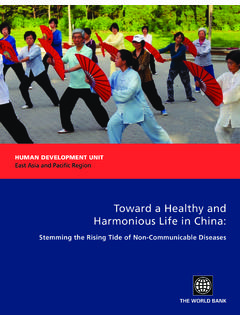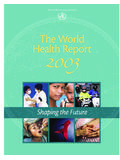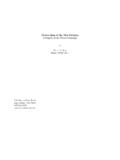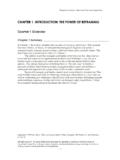Transcription of Global oral health of older people – Call for public ...
1 Community Dental health (2010) 27, (Supplement 2) 257 268 BASCD 2010 oral health of older people call for public health Petersen1, D. Kandelman2, S. Arpin2 and H. Ogawa31 world health organization , Global oral health Programme, Chronic Disease and health Promotion, Geneva, Switzerland; 2 Division of Preventive and Community Dentistry, Faculty of Dental Medicine, University of Montreal, Montreal, Canada; 3 world health organization Collaborating Centre for Translation of oral health Science, University of Niigata, Niigata, : The aim of this report is 1) to provide a Global overview of oral health conditions in older people , use of oral health services, and self care practices.
2 2) to explore what types of oral health services are available to older people , and 3) to identify some major barri-ers to and opportunities for the establishment of oral health services and health promotion programmes. Methods: A postal questionnaire designed by the world health organization (WHO) was distributed worldwide to the Chief Dental Officers or country oral health focal points at ministries of health . WHO received 46 questionnaires from countries (39% response rate). In addition, systematic data were collected from the WHO Global oral health Data Bank and the world health Survey in order to include oral health information on the remaining countries.
3 In total, the data base covers 136 out 193 countries, 71% of all WHO Member States. Results: Dental caries and periodontal disease comprise a considerable public health problem in the majority of countries. Significant disparities within and between regions are observed in epidemiologic indicators of oral disease. The prevalence rates of tooth loss and experience of oral problems vary substantially by WHO Region and national income. Experience of oral problems among older people is high in low income countries; meanwhile, access to health care is poor, in particular in rural areas.
4 Although tooth brushing is the most popular oral hygiene practice across the world , regular tooth brushing appears less common among older people than the population at large. In particular, this practice is less frequent in low income countries; in contrast, traditional oral self-care is prevalent in several countries of Africa and Asia. While fluoridated toothpaste is widely used in developed countries, it is extremely infrequent in most developing countries. oral health services are available in developed countries; however, the use of such services is low among the older people .
5 Lack of financial support from government and/or lack of third party payment systems render oral health services unaffordable to them. According to the country reports, health promotion programmes targeting older people are rare and this reflects the lack of oral health policies. Although some countries have introduced oral health promotion initiatives, worldwide there are few population-oriented preventive or curative activities currently implemented that focus specifically on the elderly. Barriers to the organization of such programmes relate to weak national health policy, lack of economic resources, the impact of poor oral health , and lack of tradition in oral health .
6 Opportunities for oral health programmes for old-age people are related to updated information on the burden of oral disease and need for care, fair financing of age-friendly pri-mary health care, integration of oral health into national health programmes, availability of oral health services, and ancillary personnel. Conclusion: It is highly recommended that countries establish oral health programmes to meet the needs of the elderly. Relevant and measurable goals must be defined to direct the selection of suitable interventions to improve their oral health .
7 The common risk factors approach must be applied in public health interventions for disease prevention. The integration of oral health into national general health programmes may be effective to improve the oral health status and quality of life of this population words: Global oral health status, need for oral health care, older people , oral health services, risk a result of decreased fertility and increased life-expectancy, the populations of most countries are ageing rapidly. By the year 2050 it is expected that an increase in the population aged 60 years or over will account for about half of the total growth of the world population (United Nations, 2007).
8 The proportion of older persons in developed countries is currently much higher than in developing countries; however, from a Global perspective the majority of older persons live in developing countries (United Nations, 2007). A notable aspect of population ageing is the progressive demographic ageing of the older population itself. Worldwide the most rapidly growing age group consists of persons aged 80 years or over. Although this age group now accounts for less than 2% of the total world population, the number of very old Correspondence to: Professor Poul Erik Petersen, Global oral health Programme, Chronic Disease and health Promotion, world health organization , 20 Avenue Appia, CH1211, Geneva 27, Switzerland.
9 E-mail: is expected to more than quadruple over the next four decades from less than 90 million in 2005 to almost 400 million in 2050 (United Nations, 2007).This demographic transition constitutes a significant challenge for health authorities worldwide, particularly because disease patterns will shift concurrently. WHO in its health Report 2002 ( world health organization , 2002a) analyzed the Global burden of disease and the ma-jor risks of disease, disability and death. The prevalence of non-communicable chronic diseases (NCDs) such as cardiovascular disease, chronic respiratory disease, cancer and diabetes, increases dramatically with age, which partly explains why these diseases are rapidly becoming the lead-ing causes of disability and mortality worldwide.
10 With age the risk of loss of healthy life years is aggra-vated because of low individual resistance, poor nutritional status, chronic disease and adverse socio-environmental 258conditions ( world health organization , 2002b). Although most people now may look forward to living longer, the risk of developing at least one chronic disease increases with age; this reflects the cumulative effect of a life-long exposure to risk factors and is not related to chronological age per se ( world health organization , 2002b). A core group of modifiable risk factors is common to many chronic diseases and injuries, including oral disease.














